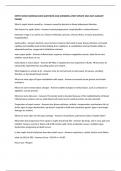SEPTIC SHOCK NURSING EXAM QUESTIONS AND ANSWERS LATEST UPDATE 2024-2025 ALREADY
PASSED
What is septic shock caused by - Answers caused by bacteria in blood widespread infection
Risk factors for septic shock - Answers Immunosuppression, hospitalization, malnourishment
Extremes of age (1 yr and 65 yr), infants w/infectious process, Chronic illness, Invasive procedures,
hospitalization
sepsis patho - Answers bacteria cause immune response that leads to poor tissue perfusion, increased
capillary permeability leads to fluid leaking from capillaries, & vasodilation interrupt bodies ability to
adequately perfuse, oxygenate & distribute nutrients
more sepsis patho - Answers inflammatory response activates coagulation system, body forms clots
whether needs them or not
Early phase or warm phase - Answers BP WDL or hypotensive but responsive to fluids. HR increases to
tachycardia, hyperthermia, bounding pulses are evident.
What happens to urinary & GI - Answers urine @ normal levels or decreased, GI nausea, vomiting,
diarrhea, or decreased bowel sounds
What are some signs of hyper metabolism with sepsis - Answers increased serum glucose and insulin
resistance
What are some mental status changes - Answers Subtle changes in mental status, such as confusion or
agitation, may be present.
What are some labs seen - Answers The lactate level is elevated because of the maldistribution of blood.
Inflammatory markers such as white blood cell counts and C-reactive protein are also elevated
Progression of sepsis causes - Answers less tissue perfusion, acidotic, compensatory mechanisms fail, pt
shows signs of organ dysfunction, bp doesn't respond to fluid and vasoactive agents, signs of end organ
damage are evident
What are some signs of end organ damage - Answers renal failure, pulmonary failure, hepatic failure
What does the progression from sepsis to septic shock look like - Answers bp drops, skin is cool, pale and
mottled. Temp is normal or below. HR & RR remain rapid. Urine production ceases, multiple organ
dysfunction progressing to death occurs.
In late septic shock/cold phase how does death occur - Answers respiratory, cardiac and/or renal failure
what are S&S of SIRS - Answers Fever >100.4F or <96.8F
Heart rate >90 bpm
, Respiratory rate >20 or PaCO2 <32 mm Hg
WBC count >12,000 cells/mm3, <4000 cells/mm3, or
>10% immature WBC (bands)
hypotension - Answers systolic <90, or drop of > = to 40 from baseline, systolic is top number, when
heart contracts
sepsis - Answers must have 2 or more SIRS criteria as a consequence of
documented or presumed infection
Severe sepsis - Answers S&S of sepsis associated with organ dysfunction, hypotension, or hypoperfusion;
How would signs of organ dysfunction be assessed - Answers Oliguria <0.5 renal failure, LOC brain
failure, coagulation disorders, liver altered or failure
clinical signs and symptoms include those of sepsis as well as septic shock - Answers • Lactic acidosis <4
• Oliguria or hypouresis
• Altered level of consciousness
• Thrombocytopenia and coagulation disorders • Altered hepatic function
septic shock - Answers Shock associated with sepsis, S&S of sepsis + hypotension and hypo perfusion
despite adequate fluid resuscitation
multiple organ dysfunction syndrome or MODS - Answers the presence of altered function of one or
more organs in an acutely ill patient requiring intervention and support of organs
What are the cardiovascular signs of MODS - Answers • Cardiovascular: hypotension and hypoperfusion
What are the respiratory signs of MODS - Answers • Respiratory: hypoxemia, hypercarbia, adventitious
breath sounds
What are the renal signs of MODS - Answers • Renal: increased creatinine, decreased urine output
What are the hematologic signs of MODS - Answers • Hematologic: thrombocytopenia, coagulation
abnormalities
What are the metabolic signs of MODS - Answers • Metabolic: lactic acidemia, metabolic acidosis
What are the neurologic signs of MODS - Answers • Neurologic: altered level of consciousness
What are the hepatic signs of MODS - Answers • Hepatic: elevated liver function tests,
hyperbilirubinemia




